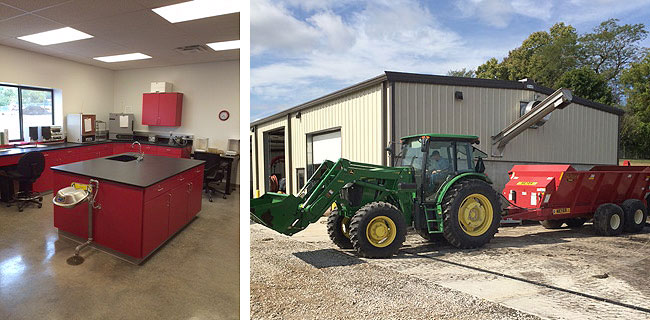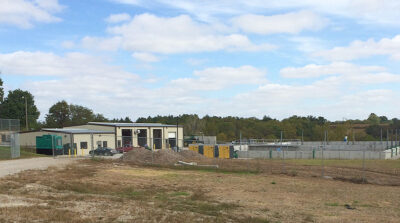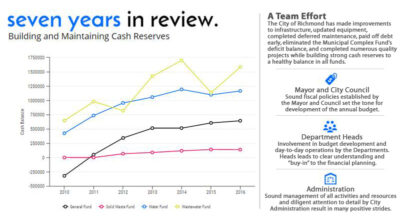Wastewater treatment is one of the single most important services a city provides its residents. The city of Richmond operated two treatment plants for more than 30 years, but growth and much-needed repairs presented a challenge that would take teamwork for success.
In 2010, voters approved a $5.1 million bond issue for existing plant upgrades that would be matched by $4 million in federal funding grants. Unfortunately, due to federal funding issues, the government grant fell through. This left the City short of the funds needed to complete the required work, estimated at $9.8 million.
Faced with a clear dilemma, the City decided to explore new options. Engineering work began. The City reapplied for loans and grants and went back to the voters with more information and a new proposal to pass an additional bond issue. A public hearing was held, informational brochures were distributed and briefings were provided to various groups throughout the community. In essence, the City informed as many people as possible by briefing various groups about the new plant and advising them that if the project was to be accomplished, voters would have to approve another $4.7 million bond issue. This totaled $9.8 million in bonds that voters faced in two consecutive years with no work other than preliminary designs completed. The City would also seek nearly $1.9 million in grants and low-interest loans through USDA and CDBG. Voters were informed that the base charge for sewer rates would be nearly $20 per connection, plus user fees.
When estimated construction costs came in more than $2 million over budget, it was quickly determined that no one had an appetite to go back to the voters a third time. As the City was scrambling for a way forward, engineers offered a new proposal for wastewater treatment; a sequencing batch reactor (SBR). SBRs represented a significant savings in construction costs due to ease of construction, fewer moving parts, and less equipment. Initially, the city staff was reluctant to accept this type of system. Concerns were allayed, however, after engineers took staff members to visit several very successful SBR operations. Another novel approach to the new plant would be a belt filter press (a dewater system) that would allow the City to save about 90 percent of costs to dispose of the treatment plant residue.
In the meantime, the City qualified to receive a $968,000 low-interest loan, a $416,100 grant from USDA, and a $500,000 grant through CDBG. The two grants provided an extra $916,100 when coupled with the $9.8 million bond authority. This resulted in slightly under the $10.8 million estimate ($10,716,100); the City was also able to commit up to $600,000 out of reserves, if needed. Contracts were awarded to Ross Construction for the plant itself and to KAT Construction for the 3.1-mile pipeline and a new 5,000,000-gallon detention basin. The combination of financing methods made the project possible.
Contractor, engineer, and staff met prior to project initiation. Everyone clearly understood the cost constraints and were ready to move forward. Formal groundbreaking was held on Aug. 28, 2013, and construction was underway. It had been more than four years since the initial decision was made to move forward, and work progressed steadily. Engineers, contractors, subcontractors, suppliers, and staff all worked exceptionally well together. Reports to USDA and CDBG were timely, and other than a few weather delays, absolutely no work stoppages or problems arose. In the course of the construction, only three minor change orders requiring additional funding were required.

The plant was complete in November 2014, with a final cost of $11.275 million. It is working superbly — meeting and far exceeding all MDNR requirements. The City recently received a series of exceptionally heavy rains; the plant processed five million gallons per day and operated well within MDNR limits for treated sewage.
This project was a major success because everyone involved — citizens, council, staff, engineers, contractors, suppliers, MDNR, and funding agencies worked as a total team. It was a textbook project.
Richmond has a wastewater treatment plant that will function for decades to come and is designed for expansion, if required. The new plant has allowed several projects in Richmond to move forward. The keys to this entire project were information, understanding, cooperation, and an unsurpassable spirit of team effort.

The entire operation, including the north pump station is controlled from one location. Above left, new lab. At right, after dewatering, sludge is removed and deposited on adjacent property.
The above was taken from an article published in the 2016 Public Works Issue of “The Missouri Municipal Review” and written by Ron Brohammer. Ron is the city administrator for the city of Richmond. He also serves in the capacity of the public works director.



